How to Create an NFT

Photo by Miglioli on Pixabay
Are you ready to dive into the exciting world of NFTs? Creating your own NFT (non-fungible token) can be a thrilling and lucrative venture, but it can also be a complex process for newcomers. Fear not, because in this article, we will guide you through the steps to successfully create your very own NFT masterpiece.
What is an NFT?
Before we delve into the process of creating an NFT, let's first understand what exactly an NFT is. NFT stands for non-fungible token, which means it is a unique digital asset that cannot be replicated or replaced. Unlike cryptocurrencies such as Bitcoin or Ethereum, which are fungible and can be exchanged on a one-to-one basis, NFTs are one-of-a-kind and have inherent value as a collector's item.
Understanding the Concept of Blockchain Technology
To truly grasp the significance of NFTs, it is important to have a basic understanding of blockchain technology. Blockchain is a decentralized digital ledger that records transactions across multiple computers, ensuring transparency, security, and immutability. NFTs are built on blockchain platforms such as Ethereum, which provide the infrastructure for creating, storing, and trading these unique digital assets.
Benefits of Creating NFTs
Now that you have a grasp of what NFTs are and the technology behind them, let's explore the benefits of creating your own NFTs. One of the key advantages of NFTs is the ability to prove ownership and authenticity of digital assets. This is especially valuable for artists and content creators, as it allows them to monetize their work in a way that was previously impossible in the digital realm.
Additionally, NFTs provide a new revenue stream for creators, as they can earn royalties every time their NFT is sold or traded. This ongoing income potential is a game-changer for artists, who can now profit from the appreciation of their work even after the initial sale. Furthermore, NFTs offer a new way for collectors to engage with and support their favorite artists, fostering a deeper connection between creators and their audience.
Step-by-Step Guide to Creating an NFT
Now that we've covered the basics, let's dive into the step-by-step process of creating your own NFT. While the exact steps may vary depending on the platform you choose, the general process remains the same.
- Selecting the Right Platform for Creating NFTs: The first step in creating an NFT is to choose the right platform. There are several popular NFT marketplaces and platforms available, each with its own unique features and offerings. Some of the most well-known platforms include OpenSea, Rarible, and SuperRare. Research each platform to find the one that best suits your needs in terms of fees, user interface, and community.
- Preparing Your Digital Asset: Once you've chosen a platform, the next step is to prepare your digital asset for minting. This could be a piece of artwork, a music track, a video clip, or any other form of digital media. It is important to ensure that your digital asset meets the specific requirements of the platform you've chosen. This may include file format, size, and resolution guidelines.
- Minting Your NFT: After preparing your digital asset, it's time to mint your NFT. Minting refers to the process of creating a unique token on the blockchain that represents your digital asset. This process typically involves connecting your wallet to the platform, specifying the details of your NFT (such as title, description, and royalty percentage), and paying a minting fee. Once the minting process is complete, your NFT is officially created and ready to be listed for sale.
Choosing the Right Platform for Creating NFTs
When it comes to creating NFTs, choosing the right platform is crucial. There are several factors to consider when selecting a platform, including fees, user interface, community, and marketplace visibility. Let's explore some of the most popular NFT platforms available today.
- OpenSea: OpenSea is one of the largest and most well-known NFT marketplaces. It offers a wide range of digital assets, including art, music, domain names, and virtual real estate. OpenSea allows users to buy, sell, and trade NFTs easily and securely. It also provides tools for creators to launch their own storefronts and collections.
- Rarible: Rarible is a decentralized marketplace that allows creators to mint, buy, sell, and trade NFTs. One of the unique features of Rarible is the ability for creators to customize their own royalty fees, ensuring they receive a percentage of future sales. Rarible also has a strong community and offers governance tokens that allow users to participate in platform decision-making.
- SuperRare: SuperRare is a curated platform that focuses on digital artworks. It aims to provide a platform for artists to showcase and sell their limited-edition digital creations. SuperRare employs a curation process to ensure the quality and uniqueness of the artworks listed on its platform. This exclusivity has made SuperRare a popular choice among collectors and artists.
Best Practices for Designing NFTs
When it comes to designing NFTs, there are a few best practices to keep in mind to maximize their appeal and marketability. Here are some tips to help you create compelling and valuable NFTs:
- Create Unique and Authentic Artwork: The key to creating a successful NFT is to make it unique and authentic. Avoid using generic or easily replicable images, and instead focus on creating something that stands out. Your artwork should reflect your style and personality, and should offer something that cannot be found elsewhere.
- Tell a Story: NFTs that tell a story or have a narrative behind them tend to resonate with collectors. Consider adding a description or backstory to your NFT, explaining the inspiration or meaning behind it. This adds depth and value to your artwork, making it more appealing to potential buyers.
- Collaborate and Connect: Collaborations between artists and collectors can result in unique and highly sought-after NFTs. Partnering with other artists or influencers in the NFT space can help expand your reach and attract a larger audience. Additionally, engaging with your audience and building a community around your NFTs can create a sense of exclusivity and increase demand.

Pricing and Selling Your NFTs
Determining the right price for your NFT can be a challenging task. Here are some factors to consider when pricing and selling your NFTs:
- Scarcity and Demand: The scarcity and demand for your NFT will play a significant role in determining its price. Limited-edition NFTs or those with a unique selling proposition tend to fetch higher prices. Additionally, the demand for your artwork, as determined by the interest and engagement it generates, can impact its value.
- Market Trends: Keeping an eye on the market trends and what collectors are currently interested in can help you price your NFTs effectively. Research similar NFTs and their selling prices to get an idea of the market value.
- Auction or Fixed Price: You can choose to sell your NFT through an auction or at a fixed price. Auctions can generate excitement and competition among collectors, potentially resulting in higher prices. On the other hand, setting a fixed price can provide stability and predictability for both buyers and sellers.
Promoting Your NFTs on Social Media and Online Marketplaces
Promoting your NFTs effectively is crucial for maximizing their visibility and attracting potential buyers. Here are some strategies to help you market your NFTs:
- Leverage Social Media: Utilize social media platforms such as Twitter, Instagram, and TikTok to showcase your NFTs and engage with your audience. Share behind-the-scenes content, sneak peeks, and updates about your upcoming NFT drops. Collaborate with influencers and participate in relevant communities to expand your reach.
- Engage with Collectors and Buyers: Building relationships with collectors and buyers can help create a loyal and dedicated audience for your NFTs. Respond to comments and messages promptly, offer exclusive perks or discounts to repeat buyers, and consider hosting virtual events or live streams to interact directly with your audience.
- List on Multiple Platforms: While it's important to choose a primary platform to list your NFTs, consider listing them on multiple platforms to increase visibility and reach a wider audience. Cross-promote your NFTs across different platforms, directing potential buyers to your primary listing.
NFT Marketplaces and Platforms to Consider
As the popularity of NFTs continues to grow, new marketplaces and platforms are emerging. Here are a few notable ones to consider:
- Foundation: Foundation is a curated NFT marketplace that focuses on art, design, and collectibles. It aims to provide a platform for emerging artists to showcase their work and gain recognition. Foundation has gained popularity for its curation process and limited-edition drops.
- Nifty Gateway: Nifty Gateway is a marketplace that focuses on limited-edition digital art and collectibles. It offers a user-friendly interface and has attracted well-known artists and celebrities. Nifty Gateway also supports the creation of AR and VR experiences within NFTs, adding an interactive element to the digital art world.
- Mintable: Mintable is a user-friendly platform that allows creators to easily mint and sell NFTs. It offers a range of features, including customizable royalties, unlockable content, and the ability to create multiple editions of an NFT. Mintable also supports the creation of dynamic NFTs that can change over time or based on certain conditions.
Conclusion: The Future of NFTs and Their Impact on the Art and Digital Industries
The world of NFTs is still in its early stages, but it has already made a significant impact on the art and digital industries. NFTs have provided a new way for artists, creators, and collectors to engage with and monetize digital assets. As the technology and infrastructure surrounding NFTs continue to evolve, we can expect to see even more exciting developments in the future.
Creating an NFT can be a rewarding and fulfilling experience, allowing you to showcase your creativity and potentially generate income from your digital creations. By following the steps outlined in this guide, choosing the right platform, and implementing effective marketing strategies, you can navigate the world of NFTs with confidence and unlock the full potential of this groundbreaking technology.
So, if you're ready to turn your digital creations into valuable NFTs and join the booming world of digital collectibles, let's get started!



































